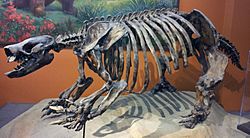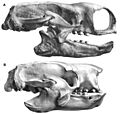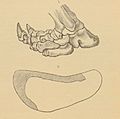Paramylodon facts for kids
Quick facts for kids Paramylodon |
|
|---|---|
 |
|
| Skeleton in San Diego | |
| Scientific classification | |
| Kingdom: | |
| Phylum: | |
| Class: | |
| Superorder: | |
| Order: | |
| Family: |
†Mylodontidae
|
| Subfamily: |
†Lestodontinae
|
| Tribe: |
†Glossotheriini
|
| Genus: |
†Paramylodon
Brown 1903
|
| Species: |
†P. harlani Owen 1840
|
Paramylodon was a giant ground sloth that is now extinct. This means it no longer lives on Earth. It was a type of mammal that lived only in North America.
This amazing animal roamed the land from about 4.9 million years ago until about 11,000 years ago. That's a very long time!
Contents
What Was Paramylodon Like?
Paramylodon was a truly huge creature. It could stand about 3 meters (almost 10 feet) tall. Imagine something as tall as a basketball hoop! It weighed as much as 1,089 kilograms (about 2,400 pounds). That's heavier than a small car!
Fossils of Paramylodon have been found in many places. These include the United States, Mexico, and even as far south as Guatemala.
Harlan's Ground Sloth
There is only one known species of Paramylodon. It is called P. harlani. People often call it Harlan's ground sloth. This name honors an American scientist named Richard Harlan. He was the first to find and describe a part of its jaw in 1835.
Special Skin and Diet
Paramylodon had a unique feature: small bones called dermal ossicles. These bones were hidden in its skin. They made its skin tougher, which helped protect it from predators. It was like having a built-in armor!
This giant sloth ate plants. Its skull and teeth show that it was a browser. This means it mainly ate leaves and small branches. It would stand on its strong hind legs to reach high branches. Then, it used its huge hands to pull the plants into its mouth.
Many complete skeletons of Paramylodon have been found. Some of the best ones come from the famous La Brea tar pits in California. These tar pits helped preserve the bones over thousands of years.
Images for kids
-
Barnum Brown, who officially named the Paramylodon genus in 1903
-
A panorama of Rancho La Brea, with a Paramylodon skeleton in the foreground at the Royal Ontario Museum
See also
 In Spanish: Paramylodon para niños
In Spanish: Paramylodon para niños











